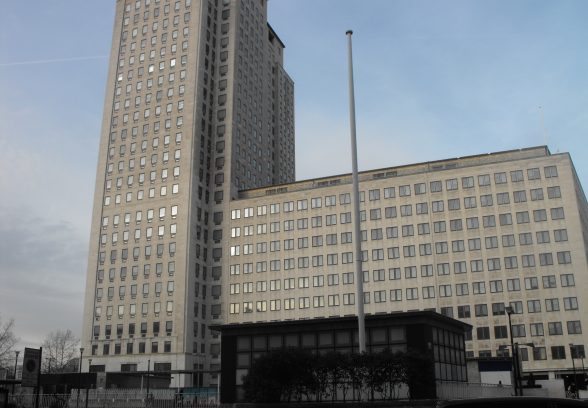This website uses cookies
This website uses cookies to enable it to function properly and to analyse how the website is used. Please click 'Close' to accept and continue using the website.



By Henrietta Billings
The Twentieth Century Society welcomes the decision this week by the Secretary of State Eric Pickles to call-in the Shell Centre scheme on London’s Southbank. We wrote to the Secretary of State for Communities and Local Government in February this year requesting he review the scheme given the enormity of the impact on the twentieth century character of this part of the capital.
In the 134,700 sq m scheme, the original Shell complex would be demolished – with the exception of the Portland stone clad 27 storey tower. The development would see a cluster of eight new towers looming over the Southbank Conservation Area with one building reaching 37 storeys high – 10 levels higher than the current Shell headquarters.
Henrietta Billings, Senior Conservation Adviser, Twentieth Century Society said “We welcome this decision by central government. The impact of a development of this scale on such a sensitive site demands more careful scrutiny. The site is one of the most iconic 20th century sites in London.”
“The scheme would result in a substantial loss of character due to the extensive demolition of a very significant complex. The cluster of new skyscrapers along the river would compromise the important landmark status of the tower, and the scheme itself not only overwhelms the site in terms of its sheer scale and height, but it fails to respect the 20th century character of the area which includes the Royal Festival Hall, Southbank Centre and National Theatre,” she added.
The building occupies a pivotal position on the South Bank in relation to views in an arc from Westminster Bridge to Blackfriars Bridge. In these views, the Shell tower is the only high building in what is relatively low rise development close to the river on its southern side. It is firmly part of the silhouette of the South Bank.
In his reasons for calling- in the application, the Secretary of State raised the following issues: the extent to which the development is consistent with Government policies in requiring good design; the extent to which the development is consistent with Government policies in planning for the conserving and enhancing the historic environment including the impact on the Westminster World Heritage site; and the extent to which the proposals are consistent with the development plan for the area. We think it is inconsistent in all three aspects.
The Shell Centre was commissioned by the company as their international headquarters in 1961 and built by Howard Robertson – most famous for the United Nations HQ in New York (1947-52). The building was locally listed in 2010 for its architecture and history, and stands in the South Bank Conservation Area – designated for its character and appearance as a unified group of modern buildings of national and international importance.
The site also acts as the back drop to Jubilee Gardens, the only area of Metropolitan Open Land in this part of London and it lies within the setting of numerous listed buildings. We believe the proposals would have a negative impact on the setting of County Hall (Grade II *) and the Victory Arch (Grade II), the Royal Festival Hall (Grade I) the Royal National Theatre (Grade II *), and Waterloo Bridge (Grade II *) .
When it was built, the Shell Centre was the largest purpose built headquarters in London, the tallest office building in the capital and possessed the largest floor area. It contained an Olympic sized swimming pool, squash courts, a rifle range, its own telephone exchange, a theatre and even a supermarket for its employees.
The building facades are finely tooled in Portland Stone with Burma teak double glazed windows, built with integrated Venetian blinds, entrances carrying the company’s symbolic scallop shell and three substantial contemporary artworks. Internally the building was decorated to the highest current standards with murals, paintings, sculpture and furniture all of which complemented the overall design.
There is no doubt that it was one of the most prestigious and innovative new headquarters building of the mid 1950s, and if it was still intact we are confident it would have been listed. This is sadly not the case, but it is still a good building of the period, and acts as an appropriate neighbour to the surrounding 20th century buildings.
Lambeth Council approved the plans earlier this year. The Twentieth Century Society requested that the Shell Centre and the neighbouring Elizabeth House re-development were called-in by the Secretary of State and determined at the same time, given their cumulative impact on the Conservation Area. The Elizabeth House proposals have not been called in.

Become a C20 member today and help save our modern design heritage.